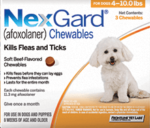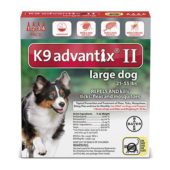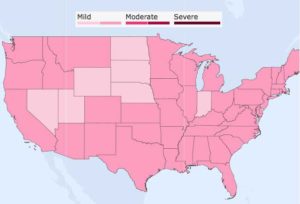Fleas + Ticks = Ugh!
Flea and tick season is upon us, and it is here a bit early this year. So, it will be more important than ever to be vigilant about keeping fleas and ticks off of our furry friends. In this post, you will find information about diseases transmitted by these pests and pros and cons of different forms of flea and tick treatments, including some home remedies.
-
Fleas and Ticks Transmit Disease1
- Some Fleaborne Diseases
- Tapeworm
- Plague
- Some Tickborne Diseases
- Lyme Disease
- Rocky Mountain Spotted Fever
- Ehrlichiosis (Dog Tick Fever)
- 1Not Comprehensive Lists
Why Treat for Fleas and Ticks?
In addition to flea and tick bites being uncomfortable to your dog, they carry many diseases that affect both dogs and humans. While ticks are more likely to spread disease than fleas, one should also avoid flea bites like The Plague–literally–as fleas are the insect vector of Yersinia pestis, the bacterium that causes Plague. The box to the right notes some illnesses transmitted by fleas and ticks.
While you or your dog may not get sick from a flea or tick bite, they can be itchy, and the bites may become infected. Preventing an infestation will prove to be worth your time and money.
| Links to More Information | |
| Disease | Information Source |
| Tapeworm | CDC.gov |
| Plague & Murine Typhus | Purdue University |
| Tickborne Diseases of the United States | CDC.gov |
When Should I Treat for Fleas and Ticks?
In most areas, the best time to start flea and tick prevention is now. The map below is a link to WebMD’s state-by-state flea and tick activity tracker, which is an interactive map showing the level of activity in each state. As you can see in the static version posted here, flea and tick activity is at least moderate in most states.
Flea and Tick Activity State by State2
2From WebMD Flea and Tick Activity Tracker. Accessed on 3/25/2017
How Should I Treat for Fleas and Ticks?
Commercial Flea and Tick Preparations

NexGard
NexGard is a chewable tablet made by Frontline Vet Labs (a Merial/Boehringer Ingelheim company). It kills fleas as well as the Lone Star tick, black-legged tick, American dog tick and brown dog tick. The active ingredient is afoxolaner. It has been proven to be safe and effective by the U.S. FDA for up to one month.
Pros: Easy to administer, U.S. FDA approved.
Cons: Pricey ($20 per dose3)
Frontline Gold

Frontline Gold is a topical solution applied to the base of your dog’s neck. Like Nexgard, Frontline Gold is made by Frontline Vet Labs. It kills fleas and ticks as well as chewing lice. Frontline Gold contains three active ingredients: fipronil, (S)-methoprene and pyriproxyfen.4 Fipronil kills adult fleas and ticks, (S)-methoprene attacks flea eggs and larvae, and pyripoxyfen helps kill the next generation of flea eggs and larvae before they become adult fleas. Frontline Gold is effective for up to one month and has been approved by the U.S. EPA.
Pros: More moderately priced than Nexgard ($13 per dose3), U.S. EPA approved.
Cons: Less convenient to administer than a chewable tablet.
K9 Advantix II
K9 Advantix II is a topical solution administered once per month that kills fleas, ticks, mosquitoes, biting flies, and lice. K9 Advantix II is made by BayerDVM. It has three active ingredients: imidacloprid, permethrin, and pyriproxyfen. K9 Advantix has been approved by the U.S. EPA.
Pros: Moderately priced ($10 per dose3). U.S. EPA approved.
Cons: Less convenient to administer than a chewable tablet
3Prices are approximate and were obtained on 3/23/2017 from web retailers.
4Frontline Gold Web Site. Accessed 3/25/2017.
Home Remedies and Alternative Medicines
Citrus Baths
 If ticks are not a problem where you live, you could try citrus juice to repel fleas. Rub your dog’s coat with juice from the citrus fruit of your choice. A word of caution, though: Citrus oil is toxic to dogs and cats,5 so be careful to only expose your pet to the juice. In this case, citrus oils are not safe for your pets even though they are natural. Also, the acid from the citrus juice could also irritate sensitive skin, so watch for sensitivities or allergies.
If ticks are not a problem where you live, you could try citrus juice to repel fleas. Rub your dog’s coat with juice from the citrus fruit of your choice. A word of caution, though: Citrus oil is toxic to dogs and cats,5 so be careful to only expose your pet to the juice. In this case, citrus oils are not safe for your pets even though they are natural. Also, the acid from the citrus juice could also irritate sensitive skin, so watch for sensitivities or allergies.
Pros: Natural, your dog will smell lemony fresh
Cons: Does not deter ticks, skin sensivitivy issues, possible adverse reactions from citrus oils.
5ASPCA Animal Poison Control: Toxic and Non-Toxic Plants. Lemon. Accessed 3/25/2017.
Essential Oil
 Essential oils are increasingly popular, and some people have used rose geranium oil to help prevent tick bites. They apply few drops to the dog’s collar. Use rose geranium oil with caution around your cat and dog as they can be toxic, and never use it on your cat. Although web sites vary on exactly which essential oils are toxic, most agree that some are. In their article “Natural Home Remedies for Flea and Tick Control,” Pet MD, advises pet owners not to use essential oils on their cat because of the possibility of a bad reaction. In addition, the ASPCA lists geraniol and linalool, which are derived from geraniums, as toxic to dogs, cats, and horses.6
Essential oils are increasingly popular, and some people have used rose geranium oil to help prevent tick bites. They apply few drops to the dog’s collar. Use rose geranium oil with caution around your cat and dog as they can be toxic, and never use it on your cat. Although web sites vary on exactly which essential oils are toxic, most agree that some are. In their article “Natural Home Remedies for Flea and Tick Control,” Pet MD, advises pet owners not to use essential oils on their cat because of the possibility of a bad reaction. In addition, the ASPCA lists geraniol and linalool, which are derived from geraniums, as toxic to dogs, cats, and horses.6
Pros: Easy
Cons: May not be effective, possibly harmful to cats and dogs
6ASPCA Animal Poison Control: Toxic and Non-Toxic plants. Geranium. Accessed 3/25/2017.
Don’t Use Garlic
Garlic is sometimes touted as an alternative and natural flea and tick preventative for dogs. However, large amounts of garlic –like those suggested for preventing fleas and ticks–can cause anemia due to damage to red blood cells, or it can cause gastrointestinal irritation.7
7ASPCA Animal Poison Control: Toxic and Non-Toxic plants. Garlic. Accessed 3/25/2017.
Counterfeit Products
In 2004 the EPA launched an investigation into the sales of counterfeit flea and tick products. This investigation resulted in a prison sentence of at least one man, and the U.S. EPA issued stop sale, use, and removal orders to retailers and other distributors of counterfeit products for use on pets.
How Can a Pet Owner Identify Counterfeit Products? The following are some of the issues identified with counterfeit products, and should serve as a red flag to consumers:
It Might Be Counterfeit If…
- There are differences in weight between the outer package and the product inside8
- There is a lack of directions in English
- The products not packaged in child-resistant packaging
- The directions for use are missing
- The product in the container is not appropriate for the animal or size of animal pictured on the outside
- There are stickers on the box to hide the foreign labeling
- The EPA registration number is missing
- It is a fgoreign labeled product with stickers containing some U.S. information
- It is a foreign-labeled product.
8U.S. EPA: Avoid Counterfeit Pesticide Products for Dogs and Cats. Accessed 3/24/2017
Do Something to Prevent Fleas and Ticks
Not treating your dog for fleas and ticks puts both you and your dog at risk for insect-borne illnesses as well as sores, infection, itching, and discomfort. Depending on the option you choose, treatment can be expensive, but you and your dog are worth being pest-free!.








